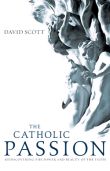 I recently read The
I recently read The
Catholic Passion by David Scott that was sent to me for
review about a year ago. I had forgotten about it and it got lost somewhere
in my book queue. I actually started running out of books to read and found
this one when I was determining what would be the next group of books to
read.
Now that I have read it I do wish that I had let it jump in line and have
read it much earlier.
This book is sort of a canvas of the Catholic faith, but not written as a
mere reciting of facts, dogmas, and doctrines – but something much deeper.
The book
concentrates much more on how the truth of the teachings of the Church are
expressed in the lives of those who live them. The Catholic Passion gives an
explanation of the faith through various examples. The book is chock full of
the writing of the Church Fathers, Saints, artists, and other catholics. The
writing style makes reading it a pleasure where before you know it you have
just gone through another chapter looking forward to the next.
The book is made up of nine chapters each around thirty pages in length starting
from a chapter on Jesus to a discussion of the life of the world to come. The
chapter on prayer is worth the price of the book alone. This is one of the
best chapters on prayer I have ever read and provides a great summary on this
topic. Though all the chapters are quite good in themselves and are all good
solid introductions into what they address whether it is the sacraments or
another topic.
I found lots of useful information and I especially enjoyed finding out that
there is a ditty from the middle ages associated with the four senses of scripture.
The letter teaches God’s deeds;
the allegorical sense what to believe;
the moral sense how to act;
the anagogical sense for what higher goal to strive.
This is quite a worthwhile book and is great for both those who
are curious about the Catholic faith and those already widely read in the faith.
David Scott is currently the editorial director of the editorial director
of The St. Paul Center for Biblical
Theology founded by Scott Hahn.

4 comments
The four senses mini-poem is in the CCC. In the English version, see the footnote to paragraph 118 for the Latin original.
I heard that the ditty originates in Origenn and can also be found in the Catechism of the Catholic Church
118 A medieval couplet summarizes the significance of the four senses:
The Letter speaks of deeds; Allegory to faith;
The Moral how to act; Anagogy our destiny.
87 Lettera gesta docet, quid credas allegoria, moralis quid agas, quo tendas anagogia. Augustine of Dacia, Rotulus pugillaris, 1: ed. A. Walz: Angelicum 6 (1929) 256.
Gosh..that leaves no good place to lug in historical-critical interpetation. So much for my scripture course.
This is the kind of book you buy, read really quick, and then get ready to loan it, with the understanding you’ve probably just given it away.
We should all be armed with books like this, locked and loaded and ready to lose to help someone else.